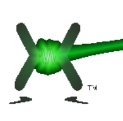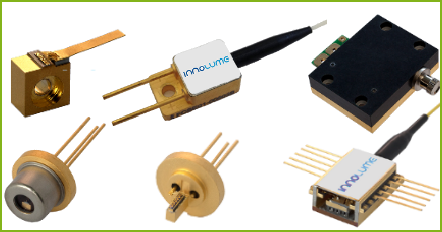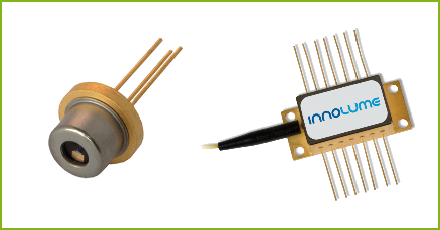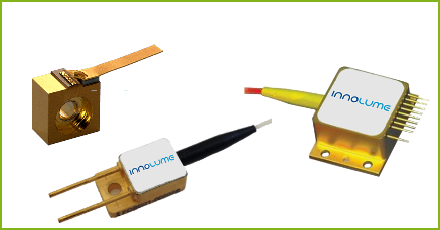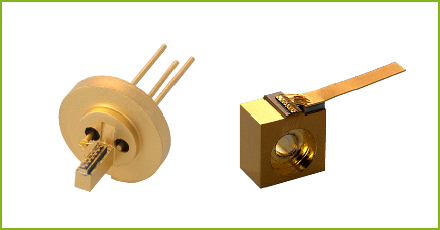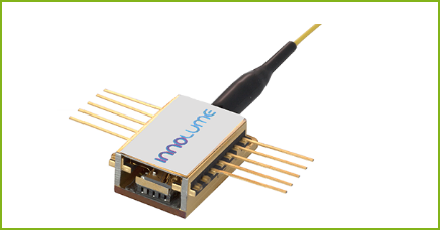


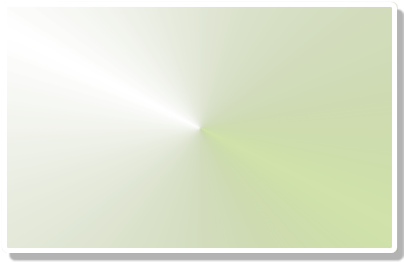

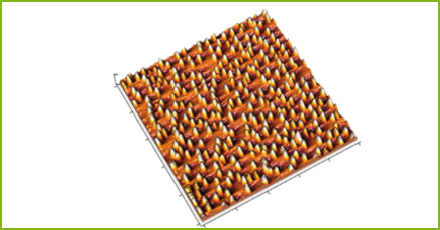
Lasers
Quantum dots are small semiconductor structures in a host medium with higher electronic (energy) bandgap. Dot dimensions typically range from 2 to 10 nm or ~10 to 50 atoms. More specifically, quantum dots for laser diodes are self-
Quantum dots constitute the gain medium in virtually all of Innolume’s semiconductor diode lasers and related products. This is because their composition, discreteness, and 3D carrier confinement provide valuable laser performance advantages over conventional quantum well heterostructures that offer only 1D confinement and exhibit strain limits. Benefits include reduced threshold current, temperature independence, broadened gain spectrum, and low relative intensity noise. Historically such advantages were more theoretical than practical since they were predicted on the basis of idealized quantum dot behaviour unperturbed by the host medium and structure. The reality is much more complicated. Full realization of the theoretical advantages has required years of MBE (molecular beam epitaxy) process development, heterostructure engineering, and device optimisation at Innolume’s Dortmund, Germany fab.
Today Innolume has achieved the promise of quantum dot nanotechnology for semiconductor lasers, as well as for associated optical devices like gain chips, semiconductor optical amplifiers (SOAs), light emitting diodes (LEDs), superluminescent diodes (SLDs), and single-
Innolume’s preferred compound semiconductor material system is InAs/GaAs, namely, indium arsenide quantum dots in gallium arsenide with aluminum gallium arsenide barriers, all on gallium arsenide substrates. The lasing wavelength window for this system is between 1064 nm and 1320 nm, controlled by quantum dot size, distribution, and indium concentration. Thus, Innolume’s quantum dot lasers fill the wavelength gap between quantum well lasers based on either GaAs (< 1100 nm) or InP (> 1300 nm). Furthermore, despite the relatively low concentration of the discrete gain medium, e.g., compared to continuous quantum well layers, quantum dots enable high power devices with high wall plug efficiency. For example, Innolume’s single-
Innolume’s technologists have been intimately involved in quantum dot nanotechnology applied to optoelectronics for decades. Virtually all technical staff trained at the world-
Innolume offers diode lasers and broadband light sources covering an unique wavelength range of 1064nm -
Laser Bars as well as Single Emitter chips and fibre coupled modules are being offered.
Applications
- medical/cosmetic laser systems
- test & instrumentation equipment
- gas sensing
- defence systems
- pumping
High power in unique wavelength range, for medical, cosmetics, materials processing and direct frequency conversion:
- 1064nm, 1210nm, 1320nm and custom wavelengths
- 600mW single-
mode ex- facet - 18W multi-
mode ex- facet - 250mW single-
mode ex- fibre - 12W multi-
mode ex- fibre - 100W+ multi-
mode ex- fibre bundle
Gain Chips
Gain Chip (GC) is the irreplaceable component as a gain medium for the building of the tunable diode laser or high stable external cavity diode laser. Gain Chip is similar to laser diode chip except the fact that it has deep antireflecting coating on one or both facets which significantly increases threshold of self lasing or eliminate it.
Typical external cavity diode laser configurations are Littrow-
Littrow / Littman
Innolume Gain Chip product line subdividing in two main categories:
1. One side optical access (Types A and B)
2. Two sides optical access (Types C and D)
One side optical access Gain Chip is ideal component for operation in the scheme where the output power is outcoupled from the external cavity. Typically they are supplied in TO-
Two sides optical access Gain Chip can be used in scheme allowing power outcoupling directly from the Gain Chip Facet to reduce the optical losses or in optical scheme for the amplification.
GainChip Types
Type A Gain Chip has straight stripe normal to the facets with high reflecting (HR) and deep antireflecting (AR) coatings. This is the most cost effective solution for the building of the external cavity diode laser. Type A GC has symmetrical beam far field providing efficient coupling to the external cavity and back using high NA aspheric lens. This type of the Gain Chips has relatively low gain spectra ripples suppression compare to the other types. It results from the fact that the reflection of the AR coated facet is on the level of 0.1% and can be further reduced by using slanted stripe-
Type B GC has curved stripe with HR-
Type C GC has curved stripe and deep AR-
Type D GC has a tilted stripe with a deep AR on both sides, typically it used for the advanced optical schemes were the build-








